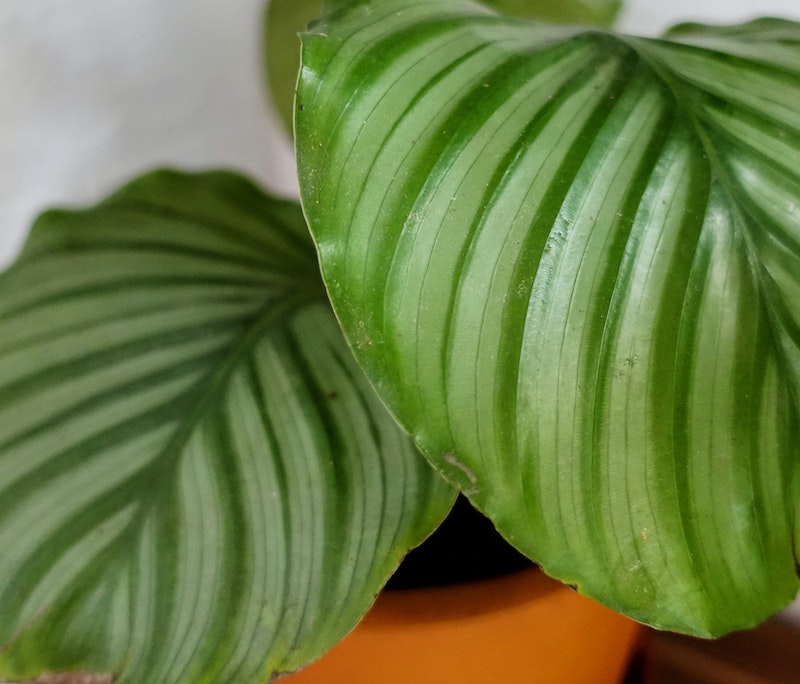Growing Calathea
Few houseplants can match the expressive, exotic foliage of the calathea. Numerous cultivars of calathea are available as houseplants, and different species go by different nicknames, including “prayer plant” and “rattlesnake plant”. These nicknames indicate the movement of the foliage as it follows the sun and the braid-patterned leaves. They may require more attention than some plant owners are able to give, but beginner and experienced growers alike can find success and enjoyment with calatheas.

Calathea Sunlight Requirements
Calatheas naturally occur under the leaf canopy in tropical rainforests. In the home environment, this translates to a preference for bright indirect light. Avoid exposing this plant to direct sunlight, as it will burn leaves and cause a loss of color. Inadequate light will also affect plant coloration and lead to a stunted, leggy growth habit. An area near an east-, south-, or west-facing window but not in the direct sun could be the perfect position for the calathea. In spots with very low light, a supplemental grow light kept on for several hours per day will help achieve the best appearance.

Planting Calathea
The ideal soil for calathea is rich in organic matter but light in texture and well drained. Consider a coco coir or peat-based potting mixture as long as it does not contain water-retentive crystals or come with excessive fertilizer. Equal parts perlite, peat moss, and well-rotted compost will provide adequate drainage and enough nutrients to avoid any supplemental fertilization for several months. Another good soil option could be a base mixture of three parts peat to one part sand. The ideal soil pH is around 6.5. A healthy, growing calathea will benefit from repotting every one to two years, ideally in the spring. Choose a container with plenty of drain holes that is one increment larger than the current container.
Watering Calathea
Water calathea thoroughly whenever the top inch of soil is dry to the touch. Irrigate slowly until water begins to exit through the drain holes of the container. Use rainwater, distilled water, or water collected from a dehumidifier whenever possible. Avoid softened water and try to minimize the use of tap water or let it sit out for a couple of days before using it. Salts and minerals in the water can damage the plant, causing brown leaf edges. Calatheas love high humidity levels. If humidity in an area consistently drops below 50 percent, consider keeping this houseplant on a pebble tray or running a humidifier nearby. Leaf edges will turn brown and dry out and leaves may curl if humidity is too low.
Fertilizing Calathea
Regular fertilizer applications will encourage vigorous, healthy growth. Apply a diluted liquid fertilizer monthly when the calathea is actively growing. Alternatively, work a slow-release, granular fertilizer into the top of the soil two to three times during the growing season. The best nutrient ratio for calatheas is 3:1:2, although most balanced fertilizers will prove adequate. When growth slows during fall and winter because of lower light levels and temperatures, halt fertilizer applications. Light green leaves and slow growth are indicators of insufficient nutrients, while the salts in excessive fertilizer applications can burn the plant’s roots, causing brown leaf tips and margins.
Common Calathea Problems
Calathea leaves droop or change orientation while following the light, but leaf droop can also indicate that a plant needs water. Yellow or brown leaf margins and tips can result from improper watering. Direct light will cause leaves to lose color and burn. Low light causes leaves to lose some of the vivid coloration of their leaves. Poorly drained soil or excessive watering can lead to root rot. Occasional pests of calathea include mealybugs, spider mites, and fungus gnats. Regular inspections of the leaves and proper watering methods help to keep these pests in check.

Propagating Calathea
The best way to propagate a calathea is by division when a plant is crowded in its current container. This is best done in spring when the plant is actively growing and can be paired with repotting. Simply remove the calathea gently from its existing container and gently tease the roots apart into two or more sections. Each section should have its own stems and a proportionate mass of roots. Place each section in a pot that is just a bit larger than the root mass and gently fill the space around the roots with soil. Keep fresh divisions in a protected area and do not fertilize the plants until new growth emerges.
Growing Calathea Outdoors
The ideal temperature range for calatheas is 65 to 85 degrees Fahrenheit. Only bring or keep this houseplant outdoors when the temperature will remain above 60 degrees Fahrenheit to avoid cold damage. Try to acclimate it to life outdoors slowly and make sure to position it in a shaded site to avoid leaf burn. Plants kept outdoors often require more frequent watering than indoor specimens. Mites may find the calathea especially attractive, particularly if conditions are warm and dry, so plan to monitor for this pest and make sure to water or mist the plant more frequently than when it is indoors.
 |
Author Angela Ryczkowski - Published 2-25-2023 |
